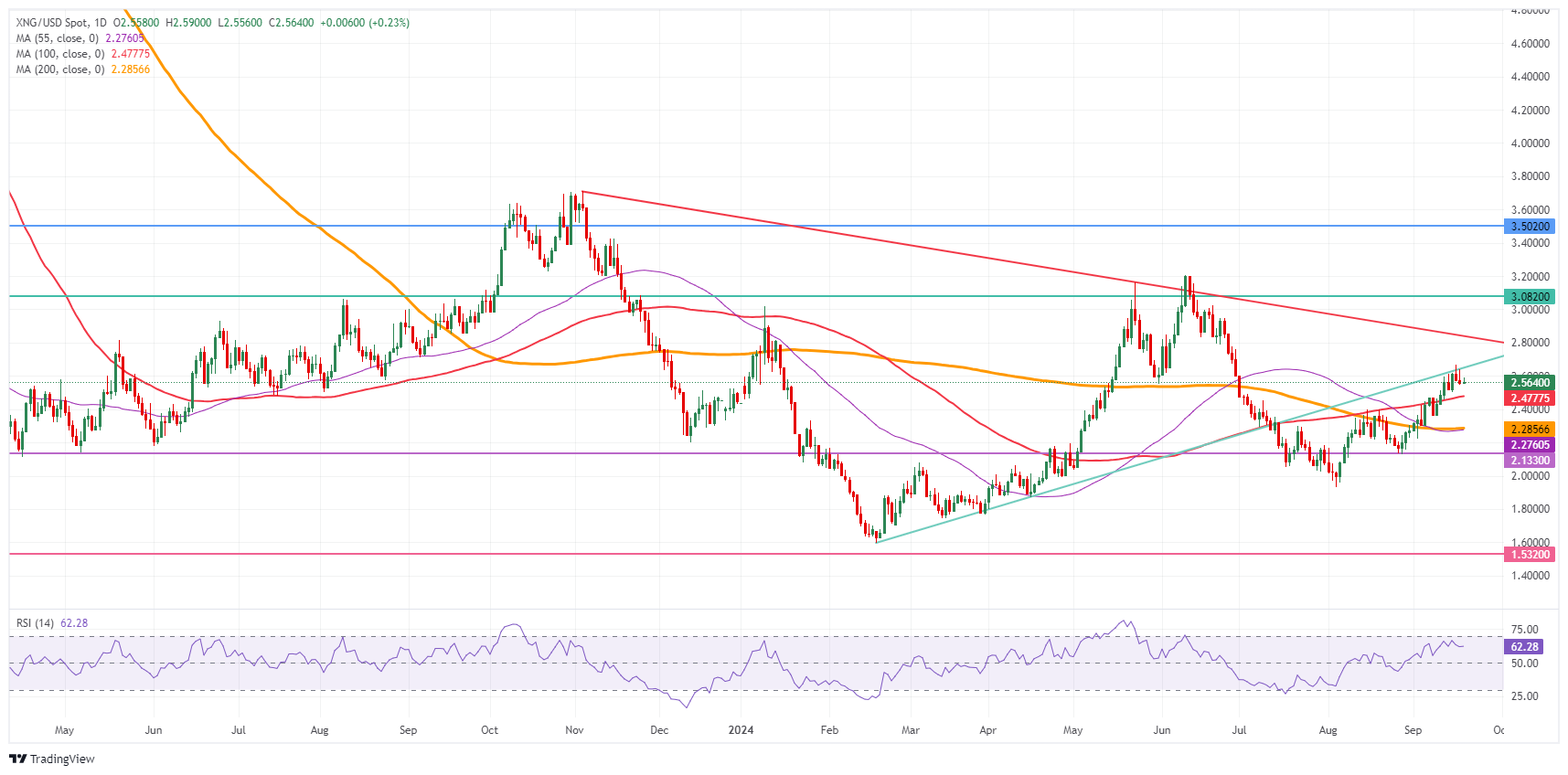Natural Gas futures reach end of the line in rally
- Natural Gas receives technical rejection on the topside after attempts to break higher.
- European Gas reserves are 93% full while the Russian transit deal ends.
- The US Dollar Index eases after the Fed delivers a 50 basis point rate cut with more to come.
Natural Gas futures trade flat on Thursday after the recent rally, which brought prices to a fair value point. On the one hand, Europe is bracing for a cold spell where temperatures are set to drop below averages. On the other hand, the recent pager and walkie-talkie bombing from Hamas members by Israel is a setback for any peace deal or ceasefire in the region.
Meanwhile, the US Dollar Index (DXY), which tracks the Greenback's value against six major currencies, is on the back foot after the US Federal Reserve (Fed) delivered a 50 basis point (bps) interest rate cut. In its forecast, the central bank projected another 50 bps rate cut to take place by the end of 2024. Equities are having a field day on the back of this and are rallying across the globe while the Greenback is dipping lower against nearly every major currency.
Natural Gas is trading at $2.56 per MMBtu at the time of writing.
Natural Gas news and market movers: Europe gears up for first test of consumption
- European weather will come to the forefront in the coming weeks and months, with projected temperatures quite below the normal averages, Bloomberg reports.
- Uniper CEO Michael Lewis reported that Europe is well equipped to continue without the Russian gas supply, Bloomberg reports. On December 31, Austria and Slovakia will see the Russian gas flow running through Ukraine end as the transit deal will not be renewed or prolonged.
- The International Energy Agency (IEA), meanwhile, is also planning to end Russian gas flows through Ukraine after a transit deal expires at the end of the year, Reuters reports.
Natural Gas Technical Analysis: Equilibrium state for now
Natural Gas prices have topped out for now. The bullish elements that could drive price action higher, such as the end of the Russian gas transit supply, have been already priced in. Europe itself has secured enough gas to go through the upcoming heating season. The only wildcard remains the geopolitical tensions, which could drive Gas prices either way.
On the upside, that blue ascending trend line in the daily chart below acts as a short-term resistance, near $2.62. Should the Gas price make its way above it, a longer-term uptrend could play out here. Further up, $2.80 and $2.83 (red descending trend line) are coming into play.
On the downside, three clear levels can be identified to provide near-term and longer-term support in case prices retrace. The first is the 100-day Simple Moving Average (SMA) at $2.47. A leg lower, both the 200-day SMA and the 55-day SMA are around $2.28, just ahead of $2.13 (a pivotal level since 2023).
Natural Gas: Daily Chart
Natural Gas FAQs
Supply and demand dynamics are a key factor influencing Natural Gas prices, and are themselves influenced by global economic growth, industrial activity, population growth, production levels, and inventories. The weather impacts Natural Gas prices because more Gas is used during cold winters and hot summers for heating and cooling. Competition from other energy sources impacts prices as consumers may switch to cheaper sources. Geopolitical events are factors as exemplified by the war in Ukraine. Government policies relating to extraction, transportation, and environmental issues also impact prices.
The main economic release influencing Natural Gas prices is the weekly inventory bulletin from the Energy Information Administration (EIA), a US government agency that produces US gas market data. The EIA Gas bulletin usually comes out on Thursday at 14:30 GMT, a day after the EIA publishes its weekly Oil bulletin. Economic data from large consumers of Natural Gas can impact supply and demand, the largest of which include China, Germany and Japan. Natural Gas is primarily priced and traded in US Dollars, thus economic releases impacting the US Dollar are also factors.
The US Dollar is the world’s reserve currency and most commodities, including Natural Gas are priced and traded on international markets in US Dollars. As such, the value of the US Dollar is a factor in the price of Natural Gas, because if the Dollar strengthens it means less Dollars are required to buy the same volume of Gas (the price falls), and vice versa if USD strengthens.

